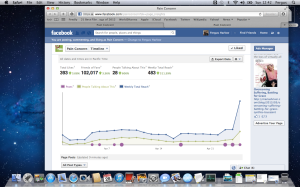The language of business is becoming outdated, with old models no longer capturing the nuance of interaction and the flow of change. Innovation no longer occurs in the lab, but in the marketplace. Communications technologies have provided the means by which business is increasingly customer lead, involving peer-production, crowd-sourcing and the need to monitor real-time changes and demands. I draw heavily on the book Social Media by Design in this short ramble, and can highly recommend it.
It’s no longer adequate to view the dynamic of online media as a one-way dissemination of information. We are now in the business of communication, in need of tools and an understanding that enables us to foster community. Value creation is increasingly determined not simply by product, but by relationships. While it was always true than an unhappy customer won’t be a returning customer, it is now true that happy, unhappy, and neutral customers are the source of business intelligence. As a business, you are no longer the expert. You need to know what your clients know.
As I recently wrote in an article:
After TEVA Canada adopted a network utilizing Microsoft SharePoint, Strategy-Nets and Moxie, they announced an unprecedented 95% order fulfilment rate for 2011. At the same time, IBM announced that they had reduced completion time by 30% and had a 33% reduction in component costs. But as Bloomberg let on that monitoring trend in online sentiment was leading to accurate stock predictions, even industry giants like Microsoft were suffering the effects of an out-dated one-way communication system. Escaping a potentially devastating 62% dissatisfaction rate in customer service provision through the generation of blogs, websites and forums, Microsoft, along with all these other companies, demonstrated the power of streamlining networks. These statistics are noted in the research of strategists such as Hinchcliffe and Kim, and indicate developments which are causing us to re-evaluate the nature of business itself.
The statistics for the page above show what happens when you aim to provide a service for your clients. The goal should be to become a resource, and not just a vendor. In order to create community, you have to offer your clients insight into the field in which you operate. This insight, and these resources, are the foundation upon which product is based. It’s how modern business develops a reputation, and this is the reasoning behind my understanding that business is increasingly about conversation, collaboration and peer-production. Product no longer determines reputation.
The controversy over the original inventor of the tablet computer demonstrates something of this philosophy. While some people are content to claim that Roger Fidler invented the tablet in 1994, Michael McNeil points out that “While mentions of electronic tablet use for specific purposes goes back to the 1800′s (Yes you read that correctly), I associate the development of the modern tablet to the visionaries that were mid-century science fiction writers. You can look specifically at Isaac Asimov’s novel “Foundation
What Apple have done is develop an image of a customer orientated organisation. The “i-” tag is no accident, and it is this image – enforced by Apple Shops full of enthusiasts rather than dour-faced wage slaves, and built upon a visionary language – combined with a way of including the customer in the product that has enabled Apple to so successfully dominate a market, and they have dominated it to such a degree that many people assume they invented the product.
Like Richard Branson is, Steve Jobs was part of the product. They are the human face of their companies, pandering to a need for a relationship with the industry consumers invest in. Along with an erroneous belief that media is for disseminating information, the attitude, tone of voice and image of the way we communicate is as an organisation is becoming more social. Formal declarations of services and a professional manner exclude people, as Hinchcliffe and Kim noted in their discussion of the Twitter account that parodied BP’s PR department during Deepwater Horizon tragedy. BP’s official PR department disseminated formal, and infrequent, updates via traditional outlets that served only to highlight their aloofness from the consumer. The Twitter parody managed to claim a larger audience than BP’s official page in a matter of weeks.
